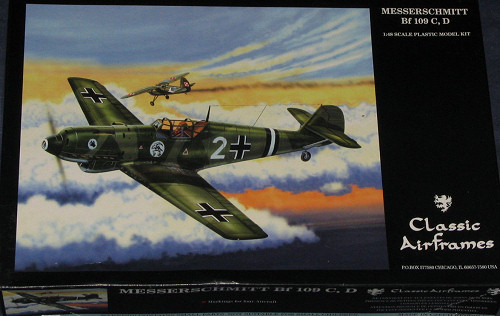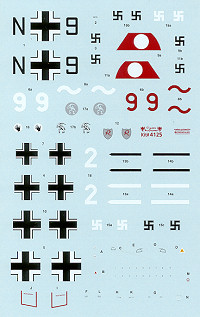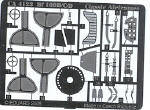
| KIT: | Classic Airframes 1/48 Bf-109C/D |
| KIT #: | 4125 |
| PRICE: | $40.00 MSRP |
| DECALS: | Four options |
| REVIEWER: | Scott Van Aken |
| NOTES: | Short run with etched brass and resin parts |

| HISTORY |
Name five WWII fighters and one of those will probably be the Bf-109. Developed from the light Bf-108 civil aircraft, the idea was to use the smallest airframe that could do the job around the most powerful engines available. It was also important that the aircraft be relatively easy to build and come in at a reasonable price. The 109 did that and beat out the more capable but more expensive to buy and more difficult to build He-112. Besides, politics raised its ugly head and since Ernst Heinkel wasn't exactly in favor at the moment, and because it was felt he should stick with bombers, the 109 was the aircraft chosen and it flew into history as the most produced German aircraft of all time.
| THE KIT |
 For
decades modelers were clamoring for a 1/48 scale early Jumo-powered Bf-109.
There were resin kits and some short run efforts around until Hobbycraft did us
a favor and produced a nice kit of this variant. Most of us were pleased with
what Hobbycraft had done, but as with all new kits, out came the micrometers and
the anal probes to find out just what was wrong with the kit. Faults were found.
The upper cowling was the wrong shape, the lower oil cooler shouldn't be flat,
the canopy was a bit too small and so on. Most of us accepted the glitches
and either used aftermarket to replace bits, filler and files to correct the
shape issues, or just built it as it was - ignorant of the horror in the box and
pleased with the end result. Besides, it was only $10 and a real bargain for the
money spent.
For
decades modelers were clamoring for a 1/48 scale early Jumo-powered Bf-109.
There were resin kits and some short run efforts around until Hobbycraft did us
a favor and produced a nice kit of this variant. Most of us were pleased with
what Hobbycraft had done, but as with all new kits, out came the micrometers and
the anal probes to find out just what was wrong with the kit. Faults were found.
The upper cowling was the wrong shape, the lower oil cooler shouldn't be flat,
the canopy was a bit too small and so on. Most of us accepted the glitches
and either used aftermarket to replace bits, filler and files to correct the
shape issues, or just built it as it was - ignorant of the horror in the box and
pleased with the end result. Besides, it was only $10 and a real bargain for the
money spent.
Time wends it way through the fabric of the universe and we now have yet another early Bf-109. This time, it is a short run kit from Classic Airframes. Knowing that the pundits could be harsh, much research was done to ensure that there were no problems. The initial boxing was for a Bf-109A , which was somewhat different from the C/D variants. Major difference was that the earlier models had longer slats, and that was taken care of. There were also differences in location of some of the other bits and pieces and those were also remedied. It seemed as if CA had managed to pull off a coup of sorts.
Websites who were on the 'gift list' were laudatory in their praise. Holidays were declared and deities created in 109-land as there was finally a Jumo-powered 109 that was accepted by the experten. Smiles and joy were everywhere.
Now for the later C/D version. Would it be the same? Would the differences in the subtypes be catered to or was there to be a sham of foisting off A/B bits to the consumer in the guise of the later variants? Well, from what I can tell, CA managed to pull off another one. The wings were replaced with the proper versions with the shorter slats, the major visual difference. However, the fuselage is the same and there are those who will note that the oxygen filler port and electrical socket were not moved back as they should have been. Not only that, but there are not any gun ports in the wings!
The horror! It must be junk as it isn't perfect. We'll have to drill our own wing gun ports!!! How could CA have missed the differences in the oxygen filler port and electrical socket? Obviously shoddy research. It ruins the overall effect and I can't have this abomination on my shelves! The accuracy police start rounding up the usual suspects and there are near suicides reported on 109 web sites.
Back in the land of sanity, let's take a look at this
one. As you know, Classic Airframes kits are produced by MPM and others. This
means that we can expect a certain level of quality. This one is quite well done with finely engraved panel lines and
the usual somewhat thick plastic with ejector towers inside all the large
pieces. I was quite pleased to notice that there is a very strong spar in the
lower wing section, so the proper wing angle shouldn't be a problem. The 109
isn't a large plane so you have one plastic sprue that is a bit too long for the
box, requiring the fuselage halves to either be cut off or 'bent' up to fit.
Fabric representation is OK, showing the expected 'hills and valleys' that we
often see. This can be reduced by sanding. Flaps and ailerons are separate as
are the rudder and elevators. As nice as these are, if you are going to pose
them in other than the neutral position, you'll probably need to do some carving
on the empennage surfaces to get a proper fit. Both a wooden and metal prop/hub
are provided, though for the C/D you'll use the metal one. A nice three piece
canopy section is provided.
 Resin
is used for a lot on this kit. You get two upper cowlings (one with ejector
exhaust and the other without), two seats, wheel wells, interior sidewalls,
cockpit 'tub' assembly, rudder pedals, wheels, slats and instrument panel. The
lower radiator cover is also resin. The rest of the small pieces are on an
Eduard-produced etched fret. This includes two styles of gear doors, radiator
grille, seat belts, instrument panel, trim wheels, rear hatch cover, and several
other bits and pieces.
Resin
is used for a lot on this kit. You get two upper cowlings (one with ejector
exhaust and the other without), two seats, wheel wells, interior sidewalls,
cockpit 'tub' assembly, rudder pedals, wheels, slats and instrument panel. The
lower radiator cover is also resin. The rest of the small pieces are on an
Eduard-produced etched fret. This includes two styles of gear doors, radiator
grille, seat belts, instrument panel, trim wheels, rear hatch cover, and several
other bits and pieces.
The instructions are typical of CA in that they are well printed and provide nicely done construction steps. There are the usual 'dry fit everything' admonishments on each page to cover them from being sued by angry builders who don't have the skills to properly build the kits (as well as to provide a blanket excuse if there are any poor fitting bits). Generic color references are provided for the construction sequence aside from RLM 02 which has a FS 595 reference as well.
Decals are provided for four aircraft. Three of them are quite similar in RLM 70/71/65 with a low fuselage demarcation line. These are from JG 132, JG 137 and an unknown unit. The fourth is from (N)JG 2 in RLM 71/02/65 and flying as a night fighter. Decals are well printed by Microscale and should not have any issues.
| CONCLUSIONS |
Overall, this is a fine looking kit that most of those who buy it will be happy with. For some it will be hard to justify $40 for this kit, but when one considers the work that may have to be done to bring the Hobbycraft kit to specs, it may well be worth it as you get both a resin set and etched brass set with the CA kit, along with good decals.
I can't let this article close without mentioning a few things. First, the box says 109C/D, but since only a handful of C models were built, this is, for all practical purposes a 109D kit as all the markings options are for the D version. Second, though you get two upper cowlings and two props, there is no definite indication of which to use aside from 'check your references'. In all probability the drawings are correct in that most, if not all D models had the ejector exhaust stubs and metal props, but it would have been nice to have it spelled out for us.
I know I'm looking forward to building this one in the near future, and judging from how well they were selling at Indy, a number of other modelers had the same idea.
| REFERENCES |
http://www.zi.ku.dk/personal/drnash/model/spain/bf109.html
Bought at great expense to myself.
March 2006
If you would like your product reviewed fairly and quickly by a site that has over 300,000 visitors a month, please contact me or see other details in the Note to Contributors.